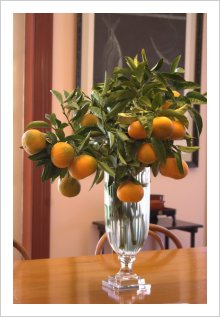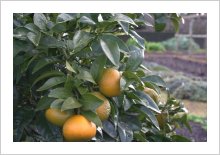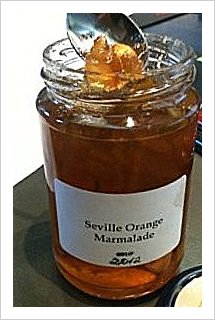Seville Oranges in the Vegetable Garden
 A favourite and essential winter job of mine is to make a year’s supply of Seville orange marmalade. I have marmalade on toast every morning for breakfast and Criss gives a fair few jars away so I need to make a lot.
A favourite and essential winter job of mine is to make a year’s supply of Seville orange marmalade. I have marmalade on toast every morning for breakfast and Criss gives a fair few jars away so I need to make a lot.
I’ve planted four Seville orange trees in the vegetable garden and get more than enough fruit even though the trees have only been growing for a few years. The tree itself is an amazingly beautiful evergreen with good dark green leaves. It is soundly frost hardy here whereas the new growth on lemon trees is cut every winter and occasionally even worse damage occurs.
 The tree of the Seville or bitter orange as it’s sometimes called is especially attractive when it is in flower during spring and again when the fruits ripen during winter. In flower it has a heavy, spicy, sweet fragrance which fills the air for many yards around it. When the fruit ripens during winter this tree is one of the joys as the oranges turn slowly from dark green to orange. A few weeks ago I picked several fruit laden branches and they looked very dramatic in a vase.
The tree of the Seville or bitter orange as it’s sometimes called is especially attractive when it is in flower during spring and again when the fruits ripen during winter. In flower it has a heavy, spicy, sweet fragrance which fills the air for many yards around it. When the fruit ripens during winter this tree is one of the joys as the oranges turn slowly from dark green to orange. A few weeks ago I picked several fruit laden branches and they looked very dramatic in a vase.
 I don’t really understand why it isn’t planted more as an ornamental. It could be used as a street tree if it were to be grafted onto a vigorous rootstock or simpler still grown from seed. Fourteen thousand of these orange trees line the streets of Seville in South Western Spain and this planting is one of that city’s major attractions.
I don’t really understand why it isn’t planted more as an ornamental. It could be used as a street tree if it were to be grafted onto a vigorous rootstock or simpler still grown from seed. Fourteen thousand of these orange trees line the streets of Seville in South Western Spain and this planting is one of that city’s major attractions.
The fruit of course is so bitter that it can’t be eaten fresh. It does however make the best marmalade. Until the end of the eighteenth century marmalade was made from quinces and was similar to modern quince paste. In 1797 Janet Keiller, who owned a small shop in Dundee Scotland (she was incidentally one of Monty Don’s forbears) was the first to use Seville oranges to make a preserve or jam. From these small beginnings one of the great jam making business empires developed, James Keiller and Sons.
The real beauty of Seville orange marmalade is the balance between the bitter and the sweet.
This is how I make marmalade. I adapted it from a recipe the artist and print maker Carolyn Graham gave me many years ago.
Ingredients
- Seville oranges
- Sugar
- Water
 I use a large stainless steel saucepan which can hold 5 or 6 oranges on one layer. The oranges are washed in water first but as I grow my own they don’t need scrubbing because there is no wax on them.
I use a large stainless steel saucepan which can hold 5 or 6 oranges on one layer. The oranges are washed in water first but as I grow my own they don’t need scrubbing because there is no wax on them.
I put the oranges in the saucepan and just cover them with water, bring to the boil and then simmer for up to an hour topping up the water occasionally. The rind should be soft by then and I turn off the heat.
After the oranges have cooled somewhat I cut them in half over the saucepan and scrape out all the flesh and pith which I put back in the cooking water. The rind should be very thin at this point.
I boil the flesh, pith and pips in the water until it starts to turn a soft gold. While this is happening using a sharp knife I cut the rind into very thin slices about a centimetre long. The thinner the rind is cut the better. I don’t use a processor but there’s no reason why not except the end product doesn’t look as attractive.
I fix a double layer of muslin, which I’ve already scalded with hot water, to a jelly strainer stand and pour the contents of the saucepan through it into another stainless steel saucepan. It doesn’t take long to strain but don’t be tempted to squeeze the last drops out of the muslin as this will make the marmalade cloudy.
I measure the volume of the liquid and add an equal amount of sugar. I finally add the cut up rind.
Then it’s just a matter of boiling it until the setting point is reached. This point is reached when a little of the marmalade is put onto a cold saucer and when cool it wrinkles with a gentle push of a finger. Put into warm sterilised jars and seal immediately.
The marmalade tastes best after the flavours have settled a bit.